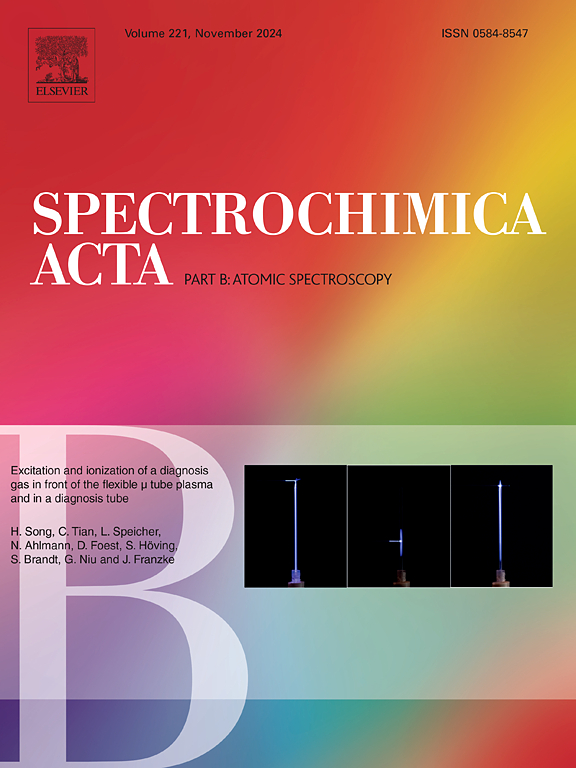10.6 μm高重复频率激光辅助LIBS对AlO分子带强度的增强
IF 3.2
2区 化学
Q1 SPECTROSCOPY
引用次数: 0
摘要
分子光谱学是分析有机材料和工业应用的关键。然而,激光烧蚀分子发射光谱往往受到光谱强度和稳定性差的限制。为了解决这一问题,本研究采用10.6 μm高重复频率激光照射辅助激光诱导击穿光谱(LIBS)来提高分子光谱的强度。首先,研究了激光功率和照射时间对AlO B2Σ+−X2Σ+Δv=0分子带强度和稳定性的影响。结果表明,增加激光功率和照射时间可显著提高光谱强度和稳定性。其次,比较了激光辐照和非激光辐照下AlO分子带的时间分辨光谱。结果表明,激光辐照提高了AlO分子带的寿命和发射强度。第三,通过拟合AlO分子带的时间分辨光谱数据,计算出激光照射下的振动温度显著升高。最后,为了进一步了解光谱增强的机理,利用COMSOL Multiphysics软件对不同温度下Al样品的烧蚀形貌进行了模拟,结果表明,光谱增强的机制主要是激光辐照引起的局部热效应。这些结果表明,10.6 μm高重复频率激光辐照辅助LIBS是提高激光烧蚀分子发射光谱灵敏度的有效方法,为有机材料分析和工业检测提供了一种新的技术途径。本文章由计算机程序翻译,如有差异,请以英文原文为准。

Intensity enhancement of AlO molecular bands with 10.6 μm high-repetition-frequency laser irradiation-assisted LIBS
Molecular spectroscopy is critical for the analysis of organic materials and industrial applications. However, laser ablation molecular emission spectroscopy is often limited by poor spectral intensity and stability. To address this issue, this study employs 10.6 μm high-repetition-frequency laser irradiation-assisted laser-induced breakdown spectroscopy (LIBS) to enhance the intensity of molecular spectroscopy. First, the effects of laser power and irradiation time on the intensity and stability of AlO molecular bands were investigated. The results showed that increasing laser power and irradiation time significantly improved both the spectral intensity and stability. Second, the time-resolved spectra of AlO molecular bands with and without laser irradiation were compared. The results indicated that laser irradiation enhanced the lifetime and emission intensity of AlO molecular bands. Third, by fitting the time-resolved spectral data of AlO molecular bands, the vibrational temperature was calculated, showing a significant increase under laser irradiation. Finally, to further understand the enhancement mechanisms, COMSOL Multiphysics software was used to simulate the ablation morphology of an Al sample at different temperatures, which revealed that the mechanism of spectral enhancement is mainly due to the local thermal effects induced by laser irradiation. These findings collectively demonstrate that 10.6 μm high-repetition-frequency laser irradiation-assisted LIBS is an effective approach to improving the sensitivity of laser ablation molecular emission spectroscopy, offering a novel technological approach for organic material analysis and industrial detection.
求助全文
通过发布文献求助,成功后即可免费获取论文全文。
去求助
来源期刊
CiteScore
6.10
自引率
12.10%
发文量
173
审稿时长
81 days
期刊介绍:
Spectrochimica Acta Part B: Atomic Spectroscopy, is intended for the rapid publication of both original work and reviews in the following fields:
Atomic Emission (AES), Atomic Absorption (AAS) and Atomic Fluorescence (AFS) spectroscopy;
Mass Spectrometry (MS) for inorganic analysis covering Spark Source (SS-MS), Inductively Coupled Plasma (ICP-MS), Glow Discharge (GD-MS), and Secondary Ion Mass Spectrometry (SIMS).
Laser induced atomic spectroscopy for inorganic analysis, including non-linear optical laser spectroscopy, covering Laser Enhanced Ionization (LEI), Laser Induced Fluorescence (LIF), Resonance Ionization Spectroscopy (RIS) and Resonance Ionization Mass Spectrometry (RIMS); Laser Induced Breakdown Spectroscopy (LIBS); Cavity Ringdown Spectroscopy (CRDS), Laser Ablation Inductively Coupled Plasma Atomic Emission Spectroscopy (LA-ICP-AES) and Laser Ablation Inductively Coupled Plasma Mass Spectrometry (LA-ICP-MS).
X-ray spectrometry, X-ray Optics and Microanalysis, including X-ray fluorescence spectrometry (XRF) and related techniques, in particular Total-reflection X-ray Fluorescence Spectrometry (TXRF), and Synchrotron Radiation-excited Total reflection XRF (SR-TXRF).
Manuscripts dealing with (i) fundamentals, (ii) methodology development, (iii)instrumentation, and (iv) applications, can be submitted for publication.

 求助内容:
求助内容: 应助结果提醒方式:
应助结果提醒方式:


